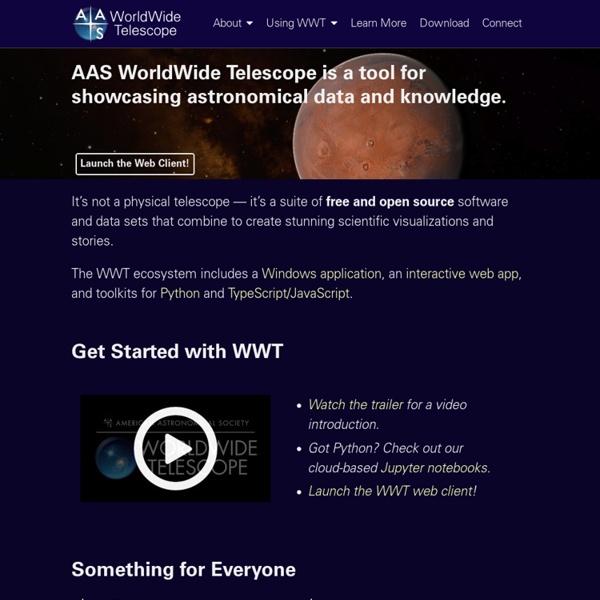



http://www.worldwidetelescope.org/home/
Related: Universe & Multiverse • Sci/TechSecret Worlds: The Universe Within - Interactive Java Tutorial Secret Worlds: The Universe Within View the Milky Way at 10 million light years from the Earth. Then move through space towards the Earth in successive orders of magnitude until you reach a tall oak tree just outside the buildings of the National High Magnetic Field Laboratory in Tallahassee, Florida. After that, begin to move from the actual size of a leaf into a microscopic world that reveals leaf cell walls, the cell nucleus, chromatin, DNA and finally, into the subatomic universe of electrons and protons. Is our Milky Way galaxy a zombie, already dead and we don't know it? Kevin Schawinski, Swiss Federal Institute of Technology Zurich Like a zombie, the Milky Way galaxy may already be dead but it still keeps going. Our galactic neighbor Andromeda almost certainly expired a few billion years ago, but only recently started showing outward signs of its demise.
Physics Flash Animations We have been increasingly using Flash animations for illustrating Physics content. This page provides access to those animations which may be of general interest. The animations will appear in a separate window. The animations are sorted by category, and the file size of each animation is included in the listing. The Cosmic Accident of Life: Alan Lightman on Dark Energy, the Multiverse, and Why We Exist Questions like why our world exists and what nothing is have occupied minds great and ordinary since the dawn of humanity, and yet for all our scientific progress, they continue to do so, yielding only hypotheses rather than concrete answers. But there is something immutably heartening in the difference between the primitive hypotheses of myth, folklore and religion, which handed off such mysteries to various deities and the occasional white-bearded man, and the increasingly educated guesses of modern science. In the title essay of his excellent The Accidental Universe: The World You Thought You Knew (public library), which also gave us this beautiful meditation on science and spirituality, Alan Lightman points to fine-tuning — the notion that the basic forces propelling our universe appear to be fine-tuned in such a way as to make the existence of life possible — as a centerpiece of how modern scientists have attempted to answer these age-old questions.
Transit Agencies We’ve been following the trend of transit agencies providing developer access to timetables, routes and more for some time. Big cities, like New York and Boston are on board and helping fuel new transit applications. There now seems to be more momentum, with organizations and influencers making the call for open data. StreetFilms talked to some of these people, several within transit companies themselves, and created A Case for Open Data (embedded below). VISTA gigapixel mosaic of the central parts of the Milky Way Want to add this gigapan to your favorites? or now. now to add this Gigapan to a group gallery.
Visions of the Future Imagination is our window into the future. At NASA/JPL we strive to be bold in advancing the edge of possibility so that someday, with the help of new generations of innovators and explorers, these visions of the future can become a reality. As you look through these images of imaginative travel destinations, remember that you can be an architect of the future. "The Elements". A Flash animation The Periodic Table The periodic table of the chemical elements (also periodic table of the elements or just the periodic table) is a tabular display of the chemical elements. Although precursors to this table exist, its invention is generally credited to Russian chemist Dmitri Mendeleev in 1869, who intended the table to illustrate recurring ("periodic") trends in the properties of the elements. The layout of the table has been refined and extended over time, as new elements have been discovered, and new theoretical models have been developed to explain chemical behavior. The periodic table is now ubiquitous within the academic discipline of chemistry, providing a useful framework to classify, systematize, and compare all of the many different forms of chemical behavior.
Android App programmers A Complete IT Solution Provider Hire Android Developer Perception System uses Android SDK and Java for developing latest Android applications. Back-to-back flybys: Asteroids buzz Earth - Technology & science - Space - Space.com Two small asteroids zipped close by Earth in back-to-back flybys of the planet Monday and Tuesday. While both space rocks came well within the moon's orbit, they posed no danger to our planet, NASA scientists say. The newfound asteroid 2012 KP24 zoomed by Earth Monday, coming within 32,000 miles (51,000 kilometers) on its closest approach, according to astronomers at NASA's Asteroid Watch at the agency's Jet Propulsion Laboratory in Pasadena, Calif.
Physicists Believe They've Discovered a Fifth Fundamental Force of the Universe Although physics may seem complicated to the uninitiated (or even to the trained professional, for that matter), it’s worth remembering that physics deals with only four known forces: gravity (which keeps us from floating off the Earth); electromagnetism (which binds electrons to atoms, and atoms to each other); and two forces that operate over very short distances—the strong nuclear force (which binds atomic nuclei together) and the weak nuclear force (which governs certain kinds of radioactive decay). But if recent experimental work in particle physics pans out, we may have to get used to the idea of a fifth force. The research outlining the evidence for this fifth force was published last week in the journal Physical Review Letters. If the discovery holds up, it will radically shake up what we know about the workings of the universe. If the research pans out, it could be particularly helpful in at least two lines of research.